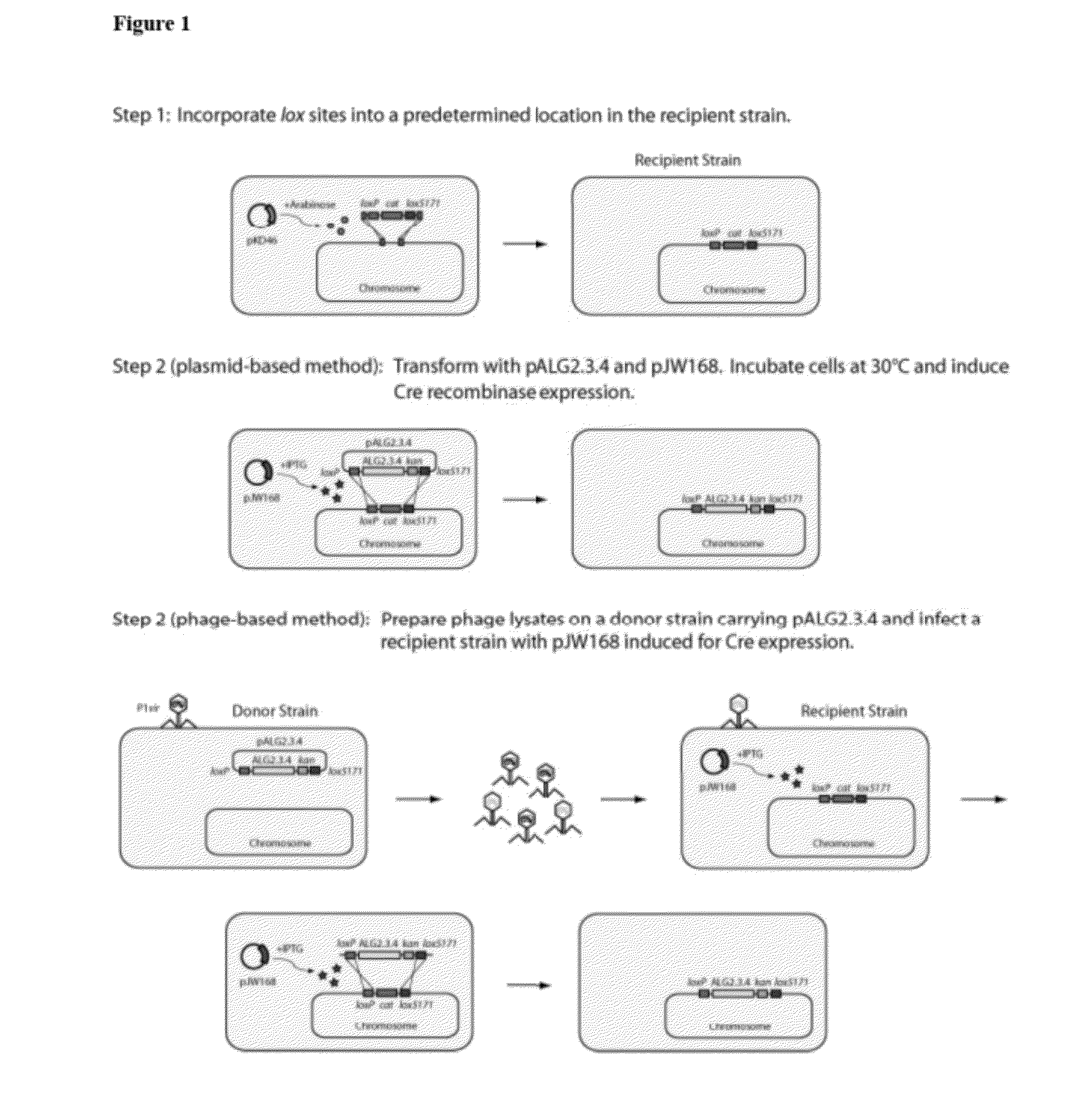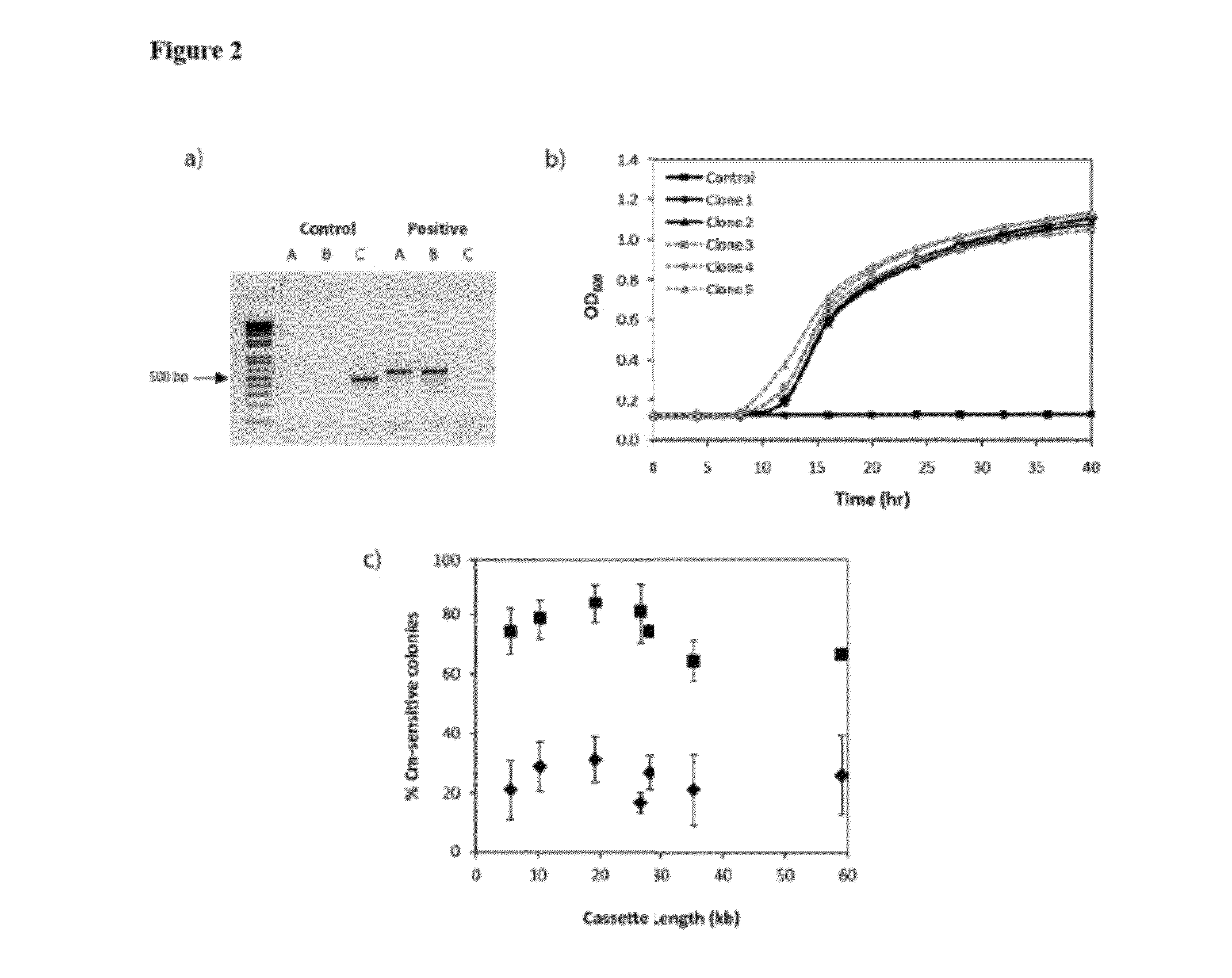Chromosomal DNA integration method
a chromosomal dna and integration method technology, applied in the field of chromosomal dna integration method, can solve the problems of inability to integrate plasmids, inability to achieve a high degree of recombination efficiency,
- Summary
- Abstract
- Description
- Claims
- Application Information
AI Technical Summary
Benefits of technology
Problems solved by technology
Method used
Image
Examples
example 1
Genomic Insertion of lox Targeting Cassette
[0127]The use of Cre-lox recombination method for fragment delivery enabled recombination of a polynucleotide into a precise and predetermined location within the bacterial chromosome. The first step in the process was to insert lox sites into the host genome.
[0128]Lox sites were integrated into the ldhA locus of E. coli ATCC 8739 ΔldhA Δfrd::adhB Δpta::pdc ΔfocA-pflB::pdc-adhB (henceforth known as BAL1075, Table 2) using λ-RED recombination (Datsenko & Wanner, 2000) and a chloramphenicol marker (cat) (Step 1 of FIG. 1). The chloramphenicol resistance gene (cat) in the construct was flanked by two lox sites: loxP and lox5171 sites (Lee & Saito, 1998). Briefly, cat was amplified from pCm-R6K with primers CS001 lox5171-Cm sense, CS002 loxP-Cm anti, and Phusion Hot-Start II DNA polymerase (New England BioLabs, Ipswich, Mass.) (Table 3).
[0129]Two distinct and mutually exclusive lox sites (loxP, lox5171) (Lee & Saito, 1998) were incorporated int...
example 2
Modification of pALG Plasmids for Cre-lox Recombination
[0133]The second step was to incorporate a complete alginate metabolic pathway (FIG. 4) into the E. coli BAL1075 (Table 2) strain using the Cre-lox recombination system. To achieve that goal, several plasmids (Tables 4 and 5) were constructed as follows.
[0134](i) Construction of pALG2.3.4-8
[0135]Two lox sites—loxP and lox5171—were introduced into pALG2.3 (Tables 4 and 5) through four rounds of sequential modifications with λ-RED recombination (Datsenko & Wanner, 2000). pALG2.3.1 was constructed by amplifying cat from pCm-R6K with primers CS009 Cm / Km horn sense and CS010 Cm anti-horn (Table 3) and transforming the resulting cassette into DH5α pALG2.3 pKD46 electrocompetent cells. This initial step was necessary to change the antibiotic resistance of pALG2.3 from kanamycin to chloramphenicol (kan to cat) in order to facilitate downstream integration steps. To insert a loxP site into pALG2.3.1 (to form pALG2.3.2), the loxP::kanFRT ...
example 3
Plasmid-Based Cre-lox Recombination
[0142]In the second step, the alginate metabolic pathway (FIG. 4) was integrated into the host genome via Cre-lox recombination. The alginate metabolic pathway was provided on a single-copy plasmid, such as pALG2.3.4, described above (Table 4). A schematic demonstrating the process is shown in Step 2 of FIG. 1.
[0143]BAL1075 ldhA::loxP-cat-lox5171 was transformed with pALG2.3.4 (Table 4) and pJW168 (Lucigen, Middleton, Wis.), a plasmid containing a temperature-sensitive replicon and an inducible Cre recombinase. After overnight growth in Luria-Bertani (LB) medium at 30° C., 25 μL was used to inoculate 2.5 mL fresh LB with 1 mM isopropy-β-D-thiogalactopyranoside (IPTG) and 12.5 μg / mL kanamycin. Cultures were grown for 3-6 hours at 30° C. and streaked out on LB-agar plates with kanamycin to isolate single colonies. After overnight growth at 37° C., individual colonies were streaked out on LB-kanamycin and LB-chloramphenicol (25 μg / mL chloramphenicol) ...
PUM
| Property | Measurement | Unit |
|---|---|---|
| temperature | aaaaa | aaaaa |
| concentration | aaaaa | aaaaa |
| volume | aaaaa | aaaaa |
Abstract
Description
Claims
Application Information
 Login to View More
Login to View More - R&D
- Intellectual Property
- Life Sciences
- Materials
- Tech Scout
- Unparalleled Data Quality
- Higher Quality Content
- 60% Fewer Hallucinations
Browse by: Latest US Patents, China's latest patents, Technical Efficacy Thesaurus, Application Domain, Technology Topic, Popular Technical Reports.
© 2025 PatSnap. All rights reserved.Legal|Privacy policy|Modern Slavery Act Transparency Statement|Sitemap|About US| Contact US: help@patsnap.com



